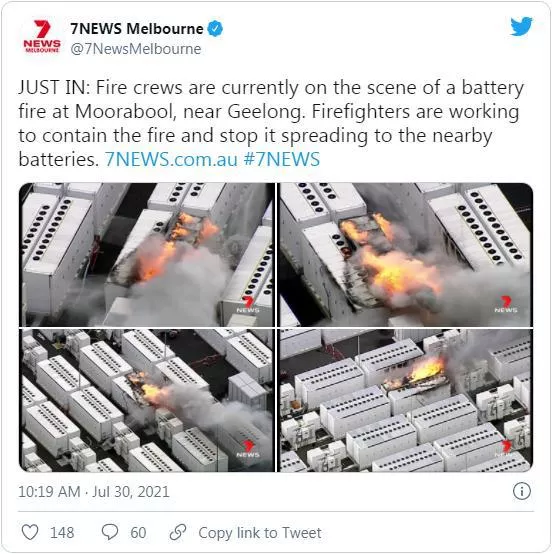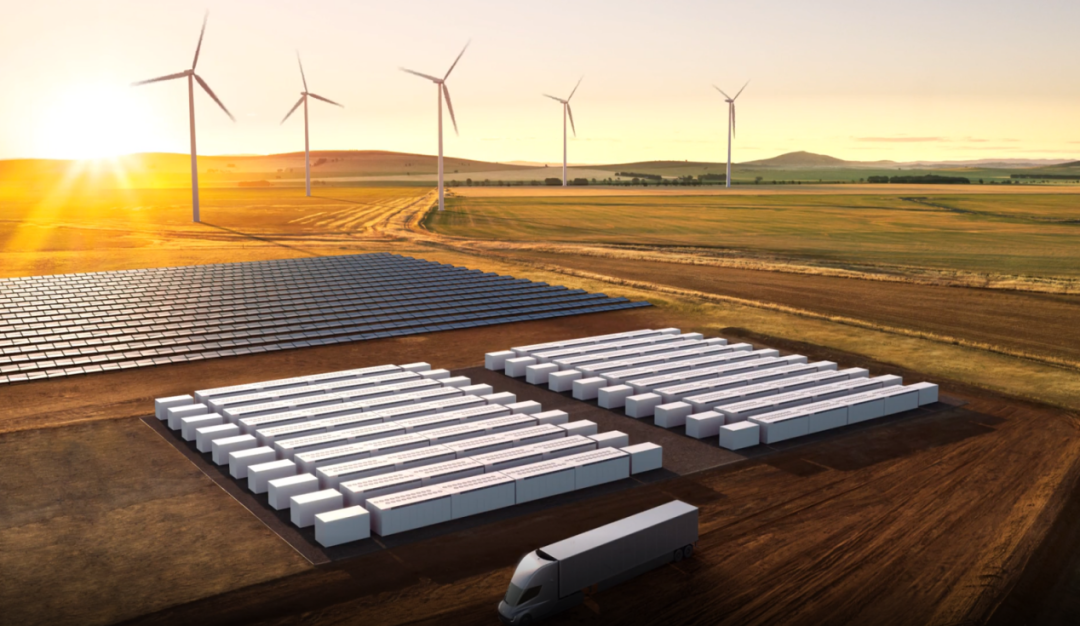Author: Kenvin
A Twitter report from 7News Melbourne, a local media in Melbourne, Australia, states that on July 30th, there was a battery fire in Moorabool, and firefighters are currently working hard to prevent the fire from spreading to adjacent battery packs. The fire involved a total of 13 tons of lithium battery packs, and the project was in the testing phase when the fire broke out. There is currently no media report on the cause of the fire.

According to online media reports, as of August 2nd, the fourth day after the fire, the local government has not yet fully controlled the fire. The Victorian Country Fire Authority stated in a statement that although the fire has visibly subsided, it has not been completely controlled.
Tesla’s Energy Storage Project
According to online reports, the site of the fire is located in the project called “Victorian Big Battery,” developed by French renewable energy giant Neoen in cooperation with Tesla for the purpose of helping Victoria achieve its goal of 50% renewable energy by 2030.

The project is operated by French energy company Neoen and uses Tesla’s lithium-ion batteries to provide services for local power load balancing. Public information shows that the energy storage capacity planned for the Victorian Big Battery project is 300MW/450MWh. The energy storage capacity of a single Megapack is about 3MWh. It is another large project of Neoen and Tesla after the successful Hornsdale energy storage project in South Australia, and it is currently the largest battery energy storage project in Australia. The main function of the project is to store the electricity generated by renewable energy such as solar and wind power in a large battery pack, and deliver it to the grid in case of power shortage to supplement and regulate the power supply in South Australia and the entire Australia.The operating company of this incident, French energy company Neoen is currently operating three energy storage projects in Australia, including the Hornsdale Energy Project, the Bulgana Wind Farm Energy Storage Project, and the Nurmurkah Photovoltaic Power Station Project in Victoria, along with the Victorian Big Battery from this incident, for a total of four energy storage projects. Neoen’s successful operation of energy storage projects not only helps South Australia solve power shortages or interruptions in extreme climate disasters, but also helps the company achieve lucrative returns.
It is reported that in 2016, South Australia experienced a statewide blackout due to extreme weather storms, causing about 1.7 million people to lose power. To solve the problem of sustainable and secure electricity supply, South Australia decided to establish a large-scale energy storage system, which was eventually awarded to Tesla.
Tesla recently announced the pricing of its Megapack industrial battery storage system, starting at $1 million. According to Tesla CEO Elon Musk, who revealed during a recent earnings conference call, Tesla’s Megapack production capacity has been sold out until the end of 2022.
The Victorian Big Battery is Australia’s largest public utility-grade battery storage project using Tesla Megapacks (Hornsdale’s previous Tesla battery used Powerpacks). A single Megapack has a length of about 7.14 meters and a width of about 1.6 meters, with a capacity of 2673kWh, which is 12 times greater than Powerpack 2.
Recently, Tesla CEO Elon Musk confirmed that the company currently has a backlog of 80,000 Powerwall orders, worth over $500 million, due to the current global chip shortage. Tesla expects to produce only 30,000 to 35,000 Powerwalls in the third quarter, less than half of the order demand.
“Accelerating the world’s transition to sustainable energy” has always been Tesla’s mission and slogan. From Tesla’s official website, it can be seen that Tesla’s energy storage system is currently divided into two types: industrial Megapack and home Powerwall. It can be noted that the Tesla industrial-grade large-scale energy storage system Megapack was used in the Victorian Big Battery project.The development direction of Tesla in energy storage is very clear. Through the advancement of technology, the use of large-capacity battery packs, Megapack, has replaced the Powerpack previously used, participating in industrial power storage or supplementing power shortages in countries or regions, and even serving as emergency backup power for important institutions such as military and hospitals. It can also participate in rescue operations for catastrophic weather. On the other hand, Powerwall is mainly used for household energy storage. Tesla has formed a complete ecosystem of photovoltaic roof, Powerwall energy storage system, Tesla vehicles, and Starlink receivers.
In the future, Tesla hopes to replace the current 21700 or 18650 batteries with the 4680 battery, which has a larger single cell energy density, to achieve greater energy storage capacity and better cost-effectiveness.
Whether it is Megapack or Powerwall, or the use of lithium-ion batteries, Tesla may switch to the no-cobalt 4680 battery, which will satisfy all Tesla fans’ cravings. During the Q2 earnings call, Musk stated that due to current manufacturing process constraints that limit production capacity, there are still many challenges to large-scale production of 4680 batteries. By the end of 2021, the annual production capacity of 4680 batteries is expected to reach 10 GWh. According to reports from the internet, after the first batch of 4680 lithium-ion batteries is put into production, they will be first used in the Giga super factories in Texas, USA and Berlin, Germany, and be assembled on the upcoming Model Y models. From the current progress, without any accidents, both the Texas and Berlin factories will begin production by the end of 2021. At that time, Tesla’s global production capacity will certainly increase, and large-scale production of 4680 batteries will also be resolved.Previously, it was believed that the 4680 battery would first appear in the new Model S Plaid+. However, Elon Musk announced that the performance of the Model S Plaid version was already superior, so the prepared Plaid+ version with 4680 battery was cancelled at the last minute before delivery, further shrouding the 4680 battery in mystery. It was once speculated that Musk cancelled the highest performance version Plaid+ because of difficulties in mass-producing the 4680 battery.
The highly anticipated Cybertruck and Semi truck are also affected by the 4680 battery’s production, and delivery dates remain uncertain, even though global Cybertruck orders have already exceeded 1.25 million.
As a Tesla battery supplier, Panasonic has already announced plans to increase investment in the US to promote mass production of the 4680 battery. Another battery supplier, LG Energy Solution, also plans to produce the 4680 battery in 2023. LG batteries have previously been manufactured in China, with a higher energy density and better safety than the current three-element lithium batteries supplied to Tesla. In the future, Chinese battery supplier CATL also has the opportunity to be authorized by Tesla to produce the 4680 battery to meet the demand in China.
Some may wonder why Tesla did not make better use of the ultra-capacitor technology obtained from Maxwell, which was acquired for $235 million in 2019. Recently, Maxwell’s ultracapacitor business was sold to UCAP Power for an unknown price. However, it is noteworthy that Tesla still owns Maxwell’s dry electrode technology. The self-developed 4680 battery utilizes this technology, which not only increases the energy density, but also greatly simplifies the manufacturing process and reduces costs, a breakthrough for price-conscious Musk. The previously announced Model S Plaid+ with the 4680 battery is expected to have a range of up to 840 km, which should alleviate most people’s range anxiety.
Tesla is not only conducting long-term research and development in battery technology, but also preparing for the supply of battery raw materials. In 2020, Tesla signed an agreement with Piedmont Lithium. Over the next five years, Tesla will purchase about one-third of the annual production of spodumene from Piedmont.
Electric ProverbThe cause of the battery fire that occurred in Australia is unknown at present. It is believed that Tesla, together with its partner Neoen, will investigate the cause of the fire after the accident. This incident may be a small episode in Tesla’s development of battery energy storage, but with Tesla’s self-developed 4680 battery, Tesla’s production of electric vehicles, photovoltaic roof, industrial or household energy storage systems and a complete closed-loop ecosystem, it can be seen that Tesla is following its own direction and pace, and is fulfilling its mission of “accelerating the world’s sustainable energy transition”.
This article is a translation by ChatGPT of a Chinese report from 42HOW. If you have any questions about it, please email bd@42how.com.